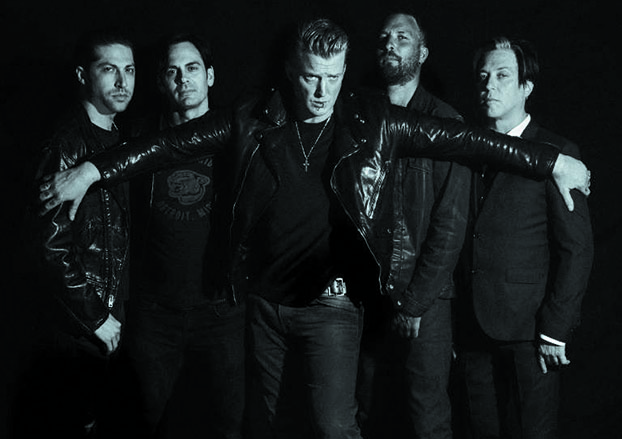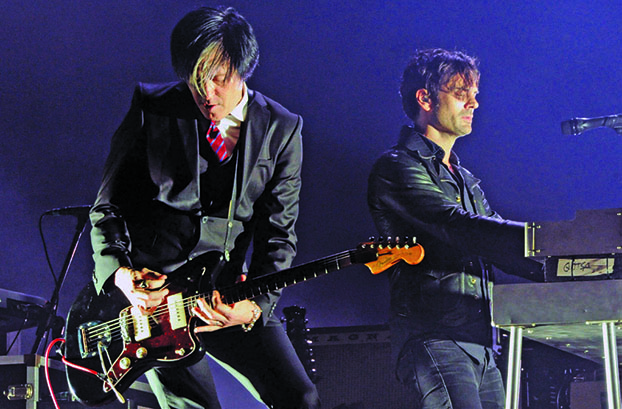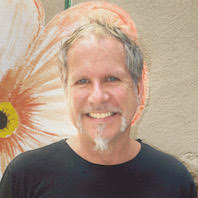Guitarists Troy Van Leeuwen and Dean Fertita Feel Most at Home in Their Modern Stone Age Family

There are few bands in rock music whose individual members have résumés as long and as impressive as those in Queens of the Stone Age.
Guitarist Troy Van Leeuwen has graced albums by A Perfect Circle, Puscifer, Eagles of Death Metal and Gone Is Gone, a new alt-metal supergroup featuring Mastodon’s Troy Sanders. Guitarist/keyboardist Dean Fertita has moonlighted with the Raconteurs, the Dead Weather and, most recently, Iggy Pop with QOTSA frontman Josh Homme.
While few bands would tolerate such infidelities, these Queens seem to thrive on it.
“I’ve been in this band for almost a decade and it just feels like home,” says Fertita. “It’s been a luxury to be in such a great group and still have the freedom to play with so many different people over the years. The idea is we’ll all grow as musicians and bring it back to the band.”
Van Leeuwen concurs. “It’s a very healthy creative environment. When we circle back to making a Queens record, we’re all recharged and psyched to play together again.”
Playing in a band with three guitarists no doubt demands an ability to work well with others, but it’s almost shocking to hear the enthusiasm the trio has for adding their piece of the puzzle.
Was there a guitar game plan going into this album?
DEAN FERTITA Conceptually, we knew we wanted this record to be very upfront. That immediately suggested looking for smaller, layered sounds that wouldn’t take up a ton of space. It was fun. We had to get creative on how we were going to do that, and not just go to some default settings that we’ve used over the years.
All the latest guitar news, interviews, lessons, reviews, deals and more, direct to your inbox!
There are a lot of guitar cooks in the kitchen in the Queens of the Stone Age. How do the arrangements get sorted out?
FERTITA Like any other band, we basically get into a room and react to each other. Having three guitar players can be challenging. There’s no room for redundancy, and we won’t play something if it doesn’t need it. We arranged these songs with the intention of tracking them as live as possible, and keeping overdubs to a minimum. We figured if we can’t play a part in the live scenario, it probably doesn’t need to be there. That saved us from getting carried away in the studio.
TROY VAN LEEUWEN Another rule of thumb was, the cleaner the tone, the better. When Jimmy Page overdubs multiple guitars, like on “In the Light” by Led Zeppelin, you’ll notice each guitar is very clean. If there’s fuzz, like on “The Way You Used to Do,” you need to work a little harder to find just the right frequencies, but that can also be fun. It’s very subtle, but I’m actually playing a 12-string on that song, which helped make the blend.
FERTITA I really wasn’t sure how “The Way You Used to Do” was going to shake out for me personally. It felt like a two-part guitar song, and it didn’t really feel like it needed keys. I thought I was going to sit that one out. But then as we got into it a little bit more, we realized, Oh, there are a couple moments here where three guitars could be really effective. That main riff. , for instance. All three guys are playing different voicings in that, to make up the sum-total of how that riff. sounds. Our tones are all just different enough that they find their own space.
Did you guys have a basic guitar setup for the album?
VAN LEEUWEN I used a Jazzmaster on many of the tracks. Not a lot of rock guitarists use it, but the Jazzmaster has a huge range. It can go from shrill and wiry to super warm with a flick of a switch, and the floating tremolo comes in handy for a lot of what I do. It’s also got a longer scale, so it takes lower tunings well for us. I tune it to C for all the older stuff, because we lived in C tuning for a long time.
Troy Van Leeuwen (left) and Dean Fertita at the Rock in Rio music festival in Brazil on September 24, 2015

Josh, Dean and I also used a variety of custom Echopark guitars. We have this amazing relationship with the owner, Gabe Currie, who worked with Leo Fender when Leo was at G&L. Gabe is the real deal American handmade guitar maker. So much so, he says that each guitar he makes, even though he sells it, is still partly his. He’ll make something and just show up at the studio and go, “I thought about you and this is what I came up with.” And he’s usually right on.
How about pedals?
VAN LEEUWEN One pedal that keeps coming back into our fold is the Eventide H9. It’s outstanding for lush and clean reverbs. The last couple albums we used tons of spring reverbs and dirty effects, but we wanted to keep that to a minimum on Villains. I also used the Way Huge Saffron Squeeze Compressor when I wanted sustain without the dirt. For fuzz, I collaborated with a company called Dr. No on something called the TVL Octavia. It’s got a great voice, and direct, it is pretty un-fuck-with-able.
FERTITA I used this Son of Kong EQ/Gain pedal by Spontaneous Audio for my direct out, and for amps I used small Gibsons and things like that. I don’t think I went larger than a 2x12 at any point. I tried a few bigger amps, but it just didn’t seem to fit.
Do you see yourself as having a specific guitar role in the band?
VAN LEEUWEN A lot of what we do stems from Josh and what he brings in. He created the band and gives it his signature. The way I see it, I’ll either support his part harmonically or juxtapose with the rhythm. But when it comes to live performance, there’s a bit more wiggle room. If there’s any chance to improvise, Dean and I are all over it.
FERTITA I always just think, if I was writing the song, what would I think would be an important element to add to it. I try to approach my parts from a songwriting point of view.
Do you have a personal favorite moment on the album?
VAN LEEUWEN I think the one that sticks out in my head is the whole intro to “Feet Don’t Fail Me Now.” The way the record starts. That whole exchange was all done live, and none of us really appreciated how great it was sounding while we were tracking it. It wasn’t until playback that we had our “a-ha” moment.
We’re always thinking about the mix when it comes to guitars, because it’s the most complicated part of what we do.
A long time ago in a galaxy far, far away Brad was the editor of Guitar World from 1990 to 2015. Since his departure he has authored Eruption: Conversations with Eddie Van Halen, Light & Shade: Conversations with Jimmy Page and Play it Loud: An Epic History of the Style, Sound & Revolution of the Electric Guitar, which was the inspiration for the Play It Loud exhibition at the Metropolitan Museum of Art in New York City in 2019.

